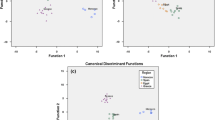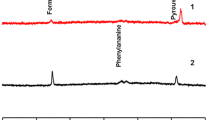Abstract
The aim of the present study was: (1) to determine the mineral content of pine and thyme honeys produced in different regions in Greece and (2) differentiate pine and thyme honeys according to their geographical origin, based on selected minerals using multivariate analysis of variance (MANOVA) and linear discriminant analysis (LDA). For this purpose, 39 pine and 42 honey samples were collected from 9 different regions in Greece known to produce such types of honey. Twenty five minerals (Ag, Al, As, B, Ba, Be, Ca, Cd, Co, Cr, Cu, Fe, Hg, Mg, Mn, Mo, Ni, Pb, Sb, Se, Si, Ti, Tl, V, and Zn) were quantified using inductively coupled plasma-atomic emission spectroscopy. Results showed that pine and thyme honeys recorded variations in their mineral content according to geographical origin. A comparison between the two honey types revealed that pine honeys possessed 92.5 % higher total mineral content, compared to thyme honeys. This was also documented, by measuring electrical conductivity of pine and thyme honeys (mean ± SD values of 1.10 ± 0.27 and 0.40 ± 0.05, respectively) which gave an excellent Pearson’s correlation (r = 1) with their total mineral content. In addition, applying MANOVA and LDA to the mineral content of each honey type, honeys were satisfactorily correctly classified according to geographical origin. The correct prediction rates were 84.6 and 83.3 % for pine and thyme honeys, respectively, using the cross-validation method. Present results showed that selected minerals in combination with chemometrics may aid to the geographical differentiation of Greek honeys.



Similar content being viewed by others
References
Gheldof N, Wang XH, Engeseth NJ (2002) Identification and quantification of antioxidant components of honeys from various floral sources. J Agric Food Chem 50:5870–5877
Reid LM, O’Donnell CP, Downey G (2006) Recent technological advances for the determination of food authenticity. Trends Food Sci Technol 17:344–353
Grube GMA (1954) Greek medicine and the Greek genius. Phoenix 8(4):123–135
Free JB (1982) Bees and mankind. George Allen and Unwin Ltd, Boston
Alqarni AS, Owayss AA, Mahmoud AA (2012) Mineral content and physical properties of local and imported honeys in Saudi Arabia. J Saudi Chem Soc 5:618–625
Madejczyk M, Baralkiewicz D (2008) Characterization of Polish rape and honeydew honey according to their mineral contents using ICP-MS and F-AAS/AES. Anal Chim Acta 617:11–17
Pohl P, Stecka H, Greda K, Jamroz P (2012) Bioaccessibility of Ca, Cu, Fe, Mg, Mn and Zn from commercial bee honeys. Food Chem 134:392–396
Bilandzic N, Dokic M, Sedak M, Kolanovic BS, Varenina I, Koncurat A et al (2011) Determination of trace elements in Croatian floral honey originating from different regions. Food Chem 128:1160–1164
Buldini PL, Cavalli S, Mevoli A, Sharma JL (2001) Food Chem 73:487–495
Escuredo O, Míguez M, Fernández-González M, Seijo MC (2013) Nutritional value and antioxidant activity of honeys produced in a European Atlantic area. Food Chem 138:851–856
Conte LS, Miorini M, Giomo A, Bertacco G, Zironi R (1998) Evaluation of some fixed components for unifloral honey characterization. J Agric Food Chem 46:1844–1849
Latorre MJ, Peňa R, García S, Herrero C (2000) Authentication of Galician (N.W. Spain) honeys by multivariate techniques based on metal content data. Analyst 125:307–312
Devillers J, Morlot M, Pham-Delégue MH, Doré JC (2004) Classification of monofloral honeys based on their quality control data. Food Chem 86(2):305–312
Terrab A, Hernanz D, Heredia FJ (2004) Inductively coupled plasma optical emission spectrometric determination of minerals in thyme honeys and their contribution to geographical discrimination. J Agric Food Chem 52:3441–3445
Fernández-Torres R, Pérez-Bernal JL, Bello-López MA, Callejón-Mochón M, Jiménez-Sánchez JC, Guiraúm-Pérez A (2005) Mineral content and botanical origin of Spanish honeys. Talanta 65:686–691
Bogdanov S, Haldimann M, Luginbühl W, Gllmann P (2007) Minerals in honey: environmental, geographical and botanical aspects. J Apic Res Bee World 46(4):269–275
Hernandez OM, Fraga JMG, Jimenez AI, Jimenez F, Arias JJ (2005) Characterization of honey from the Canary Islands: determination of the mineral content by atomic absorption spectrophotometry. Food Chem 93(3):449–458
Ioannidou MD, Zachariadis GA, Anthemidis AN, Stratis JA (2005) Direct determination of toxic trace metals in honey and sugars using inductively coupled plasma atomic emission spectrometry. Talanta 65:92–97
Alissandrakis E, Tarantilis PA, Pappas C, Harizanis PC, Polissiou M (2009) Ultrasound-assisted extraction gas chromatography-mass spectrometry analysis of volatile compounds in unifloral thyme honey from Greece. Eur Food Res Technol 229:365–373
Karabagias IK, Badeka A, Kontakos S, Karabournioti S, Kontominas MG (2014) Characterisation and classification of Greek pine honeys according to their geographical origin based on volatiles, physicochemical parameters and chemometrics. Food Chem 146:548–557
Louveaux J, Maurizio A, Vorwohl G (1978) Methods of melissopalynology. Bee World 51:125–131
SPSS, v.22.0 (2013) IBM
Field A (2009) Discovering statistics using SPSS, 3rd edn. Sage, London, p 384
Greek Directive 127/2004. Classification of monofloral honeys. Greek Ministry of Agricultural and Food Development, 67a Codex Alimentarius
Lachman J, Kolihová D, Košata J, Titěra D, Kult K (2007) Analysis of minority honey components: possible use for the evaluation of honey quality. Food Chem 101:973–979
Fredes C, Montenegro G (2006) Heavy metals and other trace elements contents in Chilean honey. Cien Inv Agr 33(1):50–58
Pisani A, Protano G, Riccobono F (2008) Minor and trace elements in different honey types produced in Siena County (Italy). Food Chem 107:1553–1560
Vanhanen LP, Emmertz A, Savage GP (2011) Mineral analysis of mono-floral New Zealand honey. Food Chem 128:236–240
de Alda-Garcilope C, Gallego-Picó A, Bravo-Yagüe JC, Garcinuňo-Martínez RM, Fernández-Hernando P (2012) Characterization of Spanish honeys with protected designation of origin ‘‘Miel de Granada’’ according to their mineral content. Food Chem 135:1785–1788
USDA Nutrient data Laboratory (2016) United States Department of Agriculture, Agricultural Research Service, USA
Joint FAO/WHO Expert Committee on Food Additives (JECFA) databases 2011 and 2013
Byrne D (2000) EC commission decision (draft), amending Annex II to council directive 92/118/EECb
Commission Regulation (EC) No. 1881/2006 setting maximum levels of certain contaminants in foodstuffs
Chudzinska M, Baralkiewicz D (2011) Application of ICP-MS method of determination of 15 elements in honey with chemometric approach for the verification of their authenticity. Food Chem Toxicol 49:2741–2749
Nozal-Nalda MJ, Yague JLB, Calva JCD, Gomez MTM (2005) Classifying honeys from the Soria Province of Spain via multivariate analysis. Anal Bioanal Chem 382(2):311–319
Council Directive 2001/110/EC relating to honey. Off J Eur Commun L10:47–52
Acknowledgments
The authors are grateful to Dr. Sofia Karabournioti for her excellent assistance in the melissopalynological analysis of honey samples, Attiki honey S.A, Athens, and to local beekeepers from Symi and Lakonia, for the donation of honey samples.
Author information
Authors and Affiliations
Corresponding author
Ethics declarations
Conflict of interest
The authors declare that they have no conflict of interest.
Compliance with ethics requirements
This article does not contain any studies with human or animal subjects.
Rights and permissions
About this article
Cite this article
Karabagias, I.K., Louppis, A.P., Kontakos, S. et al. Characterization and geographical discrimination of Greek pine and thyme honeys based on their mineral content, using chemometrics. Eur Food Res Technol 243, 101–113 (2017). https://doi.org/10.1007/s00217-016-2727-8
Received:
Revised:
Accepted:
Published:
Issue Date:
DOI: https://doi.org/10.1007/s00217-016-2727-8




